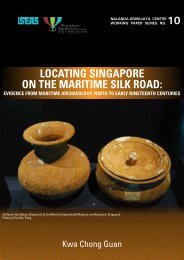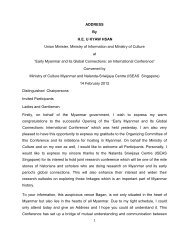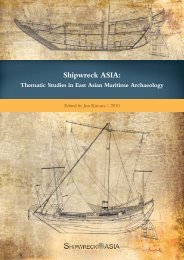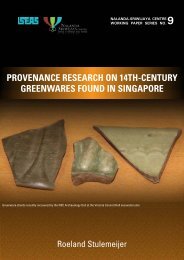You also want an ePaper? Increase the reach of your titles
YUMPU automatically turns print PDFs into web optimized ePapers that Google loves.
A Ninth-Century Arab or Indian<br />
Shipwreck in Indonesia<br />
8 Vosmer 1997, 227.<br />
is remarkably similar to the through-beams on a<br />
still extant Omani fishing craft called a battil (fig.<br />
21). 8 The angle of the through beam rebate is 72°,<br />
which is important in determining the original<br />
hull form, as discussed below.<br />
An intact through-beam was found loose on<br />
the site (fig. 22), just aft of the bow on the starboard<br />
side, but again this position is of no real<br />
significance. It is 2.7 m long, 22 cm sided on the<br />
upper surface, 25 cm sided on the lower surface,<br />
and 21 cm moulded. The beam end, where it<br />
passed through the hull, is significantly smaller<br />
in section (fig. 23). The other end has eroded to<br />
a stump, so there is no indication whether one<br />
long beam traversed the ship, or whether there<br />
was a scarf joint. It is very interesting to note that<br />
the rebate cut for the hull timbers is angled at<br />
70° for the lower plank and is nearly vertical for<br />
the upper plank, implying that there was a hard<br />
chine of sorts at this point. More importantly it<br />
implies that it was installed near midships, and<br />
that the beam of the vessel did not extend further<br />
at that point.<br />
The through-beams are made of teak (Tectona<br />
grandis). This is a magnificent timber, eminently<br />
suited to shipbuilding, particularly for hull<br />
planking, as the teak resin makes the wood resistant<br />
to toredo worm attack. It is relatively light,<br />
strong, and easily worked.<br />
Lime sealing compound<br />
A lime-like sealing compound was found on the<br />
plank edges along the longitudinal joints and, in<br />
Fig. 20 Through-beam end in situ (Drawing: M. <strong>Flecker</strong>).<br />
16 A Ninth-Century Arab or Indian Shipwreck in Indonesia

















